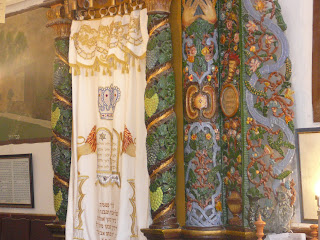Alana's friend Na'ama grew up on Kibbutz Ein Gev up on the Kinneret (Sea of Galilee). She invited us to stay on the kibbutz for a couple of nights. She picked us up late Sunday afternoon when she was finished with work and we headed out on the two-hour drive up north.
Along the way we passed several Arab towns with neon minarets and large residential homes.
Before getting to Ein Gev, Dan, Alana and Na'ama stopped at a Gelateria for some ice cream.
We arrived at the kibbutz around 8 o'clock or so. It was milking time at the dairy so we went in to see how things worked. The milking operation is computerized. Each cow has a bracelet with an identification chip in it and the cows get milked three times a day.
Even though we weren't specifically up north for birding, we still kept an eye out. What better bird to find in a barn than Barn Swallows?
The kids stayed with Na'ama in her parents' house, a beautiful home with three bedrooms. Avi and I stayed in her brother's young adult apt. while he was doing army duty during the week. It was small, but comfortable.
The kitchen was less than basic because the kibbutz has a communal dining hall. Na'ama's mother is one of the workers there for breakfast.
To conclude your tour of our accommodation, this is the exterior of the young adult quarters.
For comparison, this is Na'ama's parents' house:
The next day we took a guided tour of Tzfat (Safed), the Golan Heights, and a stop at one of the wineries in the Golan. We booked Jacob Firsel for the task and it worked out well; he was knowledgeable, fairly neutral in his politics (well, except for the time at the Golan Heights), and had a great air-conditioned vehicle that fits up to seven people.
Our first stop for the day was Tzfat, from whence comes Kabbalah, art, textiles, and many of our current Jewish traditions and prayers.
Tzfat was also an active region during several of Israel's battles. The mortar shell in Jacob's hands was one that fell on a home during the Hezbollah shelling of northern Israel in 2008.
The stained glass window is a representation of the Tree of Life.
During the 1948 War of Independence, congregants were in the synagogue. One congregant, sitting in a seat by the bima, bent forward in prayer at the exact moment a piece of shrapnel embedded itself exactly where his head would have been. You can see it just above Dan's head. This event is considered one of the many miracles to have occurred in Tzfat.
Not directly related to Tzfat is this plant, which grows in Israel -- it's product is the yummy caper.
We also visited the Abuhav Sephardic Synagogue. It was first built in the 16th century. It has three Arks. The one on the right holds a Sefer Torah which is nearly 500 years old by Rabbi Isaac Abuhav of Portugal. The Ark on the left used to hold a Koran -- it was part of the law when the Ottomans ruled Tzfat.
The decorations in the synagogue are beautiful and symbolic. In accordance with Kabbalistic tradition, the sysnagogue is designed according to numerical significance: one bima, two stairways up to it, three Arks, etc.
The reason for the rosette at the crossbeams is so the crossbeams would not form a cross.
Jews came to Tzfat as weavers. Sadly, we were told there's only one weaving company left in town. This is one of their looms.
After Tzfat we stopped for lunch at a Druze restaurant serving the best falafel we've ever had. Here we are, surrounded by the selection of salads, pickles, bread, hummus, tehina, etc., etc., etc. I wish I could remember the name of the restaurant, because it was amazing!
The Turkish coffee that followed the meal wasn't too shabby either. Alana didn't have any -- she's just the model for the "ad".
No trip to the north is complete without a stop at the Golan Heights, captured in the 1967 war. The following photos have us looking down into Syria, a strategic position that helped Israel triumph when it was attacked in 1973.
We returned to Ein Gev in time to watch the beautiful sunset over the Kinneret.
Of course, there were birds here as well. A Hoopoe, poking the soil for its insect meals,
Hooded Crow, sitting on a chair by the water,
and a non-native Peacock, probably kept around for "decoration", although it acts as an effective wake-up alarm in the morning.
































No comments:
Post a Comment